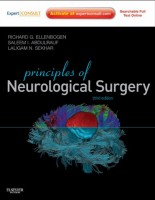 Editors: Richard G. Ellenbogen, MD; Saleem I. Abdulrauf, MD, and Laligam N. Sekhar, MD
Editors: Richard G. Ellenbogen, MD; Saleem I. Abdulrauf, MD, and Laligam N. Sekhar, MD
Publisher: Elsevier Saunders – 820 pages
Book Review by: Nano Khilnani
This unique book provides you a comprehensive look into neurosurgery. It is helpful for you as a medical student interested in and considering this specialty, resident, or already a practitioner.
What it provides you is voluminous and wide-ranging information (and insights from experienced physicians), from general principles to detailed surgical techniques. It also gives you necessary perspectives on this type of surgery and informs you of the skills you need to acquire, to become a good neurosurgeon.
This edition of the book gives you knowledge relating to:
- The latest advances in neuro-imaging
- Medical and surgical treatment of epilepsy
- Minimally invasive techniques
- New techniques in positioning patients for incisions and other procedures
- Videos at www.expertconsult.com that show you key procedures
This book contains 53 chapters organized around eight Parts, namely:
- General Overview
- Pediatric Neurosurgery
- Vascular Neurosurgery
- Trauma
- Spine
- Tumors
- Radiosurgery
- Functional / Pain
The content in this book is presented to you from several approaches: an overview of the entire field of neurosurgery; surgery relating to children; surgery pertaining to two parts of the body – blood vessels and spine; and surgery under certain conditions, namely trauma, tumors, and pain.
The topics you will find covered in this wide-ranging book are:
Part 1 – General Overview: clinical evaluation of the nervous system; landmark events in the history of neurosurgery; principles of modern neuro-imaging; and principles of surgical positioning.
Part 2 – Pediatric Neurosurgery: causes of non-traumatic hemorrhagic stroke; Chiari malformations and syringohydromyelia; developmental abnormalities; diagnosis and surgical options for craniosynostosis; hydrocephalus; posterior fossa and brainstem tumors in children; and spinal dysraphism and tethered spinal cord.
Part 3 – Vascular Neurosurgery: cavernous malformations and management strategies; cerebral revascularization for giant aneurysms of the transitional segment; endovascular neurosurgery; spontaneous intracerebral hemorrhage; and vascular malformations.
Part 4 – Trauma: closed head injury; intracranial hypertension; penetrating brain injury; and traumatic skull and facial fractures.
Part 5 – Spine: acute nerve injuries; craniovertebral junction; degenerative spine disease; entrapment neuropathies; injuries to the cervical spine; intradural extramedullary and intramedullary spinal cord tumors; pediatric and adult scoliosis; spinal cord injury; syringomyelia; thoracolumbar spine fractures; and treatment of spinal metastatic tumors.
Part 6 – Tumors: cerebellopontine angle tumors; craniopharyngiomas and suprasellar tumors; endoscopic approaches to ventricular tumors and colloid cysts; low-grade and high-grade gliomas; meningiomas; metastatic brain tumors; microsurgical approaches to the ventricular system; pituitary tumors; skull base approaches; and tumors of the pineal region.
Part 7 – Radiosurgery: application of current radiation delivery systems and radiobiology; radiosurgery of central nervous system tumors; and stereotactic radiosurgery of vascular malformation.
Part 8 – Functional / Pain: basic principles of deep brain stimulation for movement disorders, neuropsychiatric disorders, and new frontiers; extratemporal procedures and hemispherectomy for epilepsy; spasticity; surgery for temporal lobe epilepsy; surgical therapy for pain; and trigeminal neuralgia.
In addition to the material for this text outlined above (which is accessible online – see instructions below), also available for you are online videos on the following subject matter:
- The Chiari Malformations and Syringohydromyelia
- Posterior Fossa and Brainstem Tumors in Children
- Spontaneous Intracerebral Hemorrhage
- Endovascular Neurosurgery
- Intradural Extra- and Intramedullary Spinal Cord Tumors
- Cerebellopontine Angle Tumors
- Aneurysm Surgeries
- Arterial Venous Malformation (AVM) Surgeries
- Approaches for Brainstem and Thalamic Legions
- Operative Approaches to Supra-Sellar and Third Ventricular \Regions EC / IC Bypass Surgeries
- Special Technical Nuances
You will also find more information online under the Online Cases Studies Contents heading.
Among the types of cases you will find are: aneurysm bypass cases; aneurysm clipping cases; bypass cases for ischemia; arteriovenous malformation (AVM) cases; brainstem cavernoma; and cervical tumors.
The material for the 53 chapters of this book was authored by 154 doctors from all over the United States and from these countries: Argentina, Austria, Belgium, Canada, China, Greece, India, Italy, Mexico, and Slovakia.
You can access the contents of this book online through any Internet-ready device. You can also search all Expert Consult titles you own. And link to PubMed abstracts.
If you are already registered,
- Login at www.expertconsult.com
- Scratch off grey coating on inside front cover of your book to get your Activation Code
- Enter that into the Add a Title box
- Click Activate Now
- Click the title under My Titles
If you are a first-time user,
- Register
- Click Register Now at www.expertconsult.com
- Fill in your information and click Continue
- Activate your book
- Scratch off grey coating on inside front cover of your book to get your Activation Code
- Enter it into the Enter Activation Code box
- Click Activate Now
- Click the title under My Titles
This is an excellent textbook and online resource in neurological surgery because it enables you to learn procedures by watching them being performed in videos; get your knowledge updated by recent advances in neurosurgery; applying the latest techniques presented; get information quickly thanks to streamlined presentation and layouts using about 1,000 full-color illustrations. All this and more was made possible with the efforts of the three editors named below and more than 150 other doctors, too many to mention here.
Editors:
Richard G. Ellenbogen, MD, FACS is Professor (Theodore S. Roberts Endowed Chair) and Chairman of the Department of Neurological Surgery at the University of Washington in Seattle, Washington.
Saleem I. Abdulrauf, MD, FAANS, FACS is Professor and Chairman of the Department of Neurological Surgery at St. Louis University School of Medicine; Director of the St. Louis University Center for Cerebrovascular and Skull Base Surgery; and Neurosurgeon-in-Chief at St. Louis University Hospital in St. Louis, Missouri.
Laligam N. Sekhar, MD, FACS is Vice Chairman of the Department of Neurological Surgery at the University of Washington in Seattle, Washington. He is also the William Joseph Leedom and Bennett Bigelow Professor and Director of Cerebrovascular and Skull Base Surgery at that institution.







